Martin Peak (Olympic Mountains)
Martin Peak is a mountain summit in the Olympic Mountains and is located in Jefferson County of Washington state. It is located within Olympic National Park. At 7,638 feet (2,328 m) high, Martin Peak is the seventh-highest peak of the Olympic Mountains, and the second-highest peak in The Needles range, which is a subset of the Olympic range.[1] Its nearest higher neighbor is Mount Johnson, 0.53 mi (0.85 km) to the north-northwest.[1] Precipitation runoff from this peak drains west into headwaters of Gray Wolf River, or east into Royal Creek, both of which are part of the Dungeness River drainage basin. Martin Peak was given its name based on the first ascent in 1940 by George W. Martin (1901–1970), and Elvin Johnson.[4]
| Martin Peak | |
|---|---|
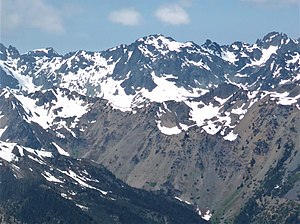 Martin Peak centered, from east. (Mt. Johnson to right) | |
| Highest point | |
| Elevation | 7,638 ft (2,328 m) [1] |
| Prominence | 238 ft (73 m) [1] |
| Parent peak | Mount Johnson |
| Isolation | 0.54 mi (0.87 km) [2] |
| Coordinates | 47°49′31″N 123°14′01″W [1] |
| Geography | |
 Martin Peak Location of Martin Peak in Washington  Martin Peak Martin Peak (the United States) | |
| Location | Olympic National Park Jefferson County, Washington, US |
| Parent range | Olympic Mountains |
| Topo map | USGS Mount Deception |
| Geology | |
| Age of rock | Eocene |
| Climbing | |
| First ascent | 1940 |
| Easiest route | class 3 scramble[2][3] |
Climate
Martin Peak is located in the marine west coast climate zone of western North America. Most weather fronts originate in the Pacific Ocean, and travel northeast toward the Olympic Mountains. As fronts approach, they are forced upward by the peaks of the Olympic Range, causing them to drop their moisture in the form of rain or snowfall (Orographic lift). As a result, the Olympics experience high precipitation, especially during the winter months in the form of snowfall. During winter months, weather is usually cloudy, but, due to high pressure systems over the Pacific Ocean that intensify during summer months, there is often little or no cloud cover during the summer. Because of maritime influence, snow tends to be wet and heavy, resulting in avalanche danger. However, Martin's location puts it in the rain shadow of the Olympic Range, resulting in less precipitation than Mount Olympus and the western Olympics receive. The months July through September offer the most favorable weather for viewing and climbing this peak.[3]
Geology
The Olympic Mountains are composed of obducted clastic wedge material and oceanic crust, primarily Eocene sandstone, turbidite, and basaltic oceanic crust.[5] The mountains were sculpted during the Pleistocene era by erosion and glaciers advancing and retreating multiple times.
References
- "Martin Peak". Peakbagger.com. Retrieved 2020-06-17.
- ""Martin Peak" - 7,638' WA". listsofjohn.com. Retrieved 2020-06-17.
- Martin Peak, climbersguideolympics.com
- Parratt, Smitty (1984). Gods and Goblins: A Field Guide to Place Names of Olympic National Park (1st ed.).
- Alt, D.D.; Hyndman, D.W. (1984). Roadside Geology of Washington. pp. 249–259. ISBN 0-87842-160-2.
Gallery
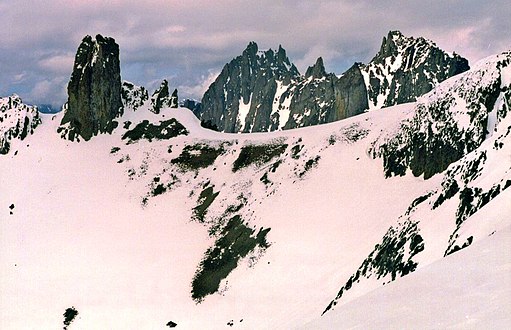 Martin Peak (right) seen with Gilhooley Tower and Mt. Johnson
Martin Peak (right) seen with Gilhooley Tower and Mt. Johnson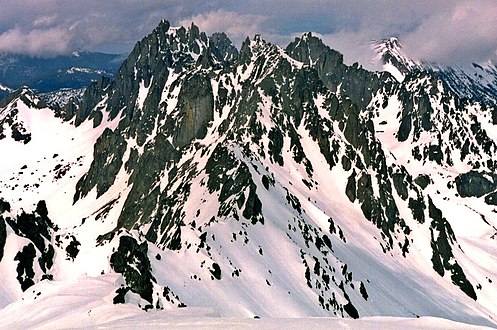 The Needles from Mount Deception. Martin Peak front and center
The Needles from Mount Deception. Martin Peak front and center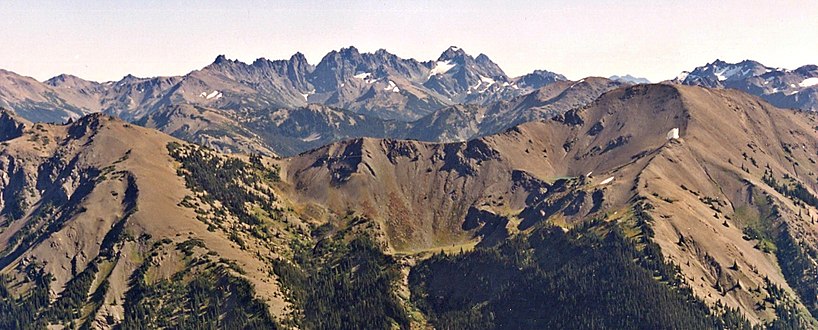 The Needles seen from Elk Mountain
The Needles seen from Elk Mountain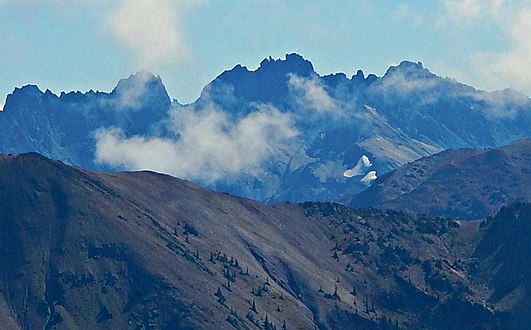 Martin Peak to right, from northwest
Martin Peak to right, from northwest
External links
- George W. Martin biography: americanalpineclub
- "Olympic National Park". National Park Service.
- National Weather Service: weather forecast